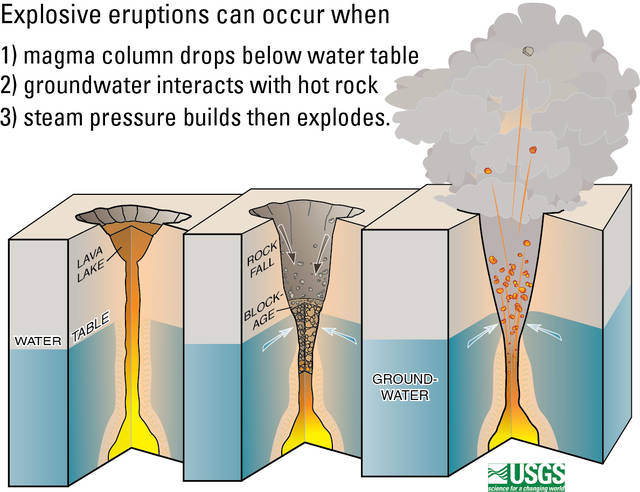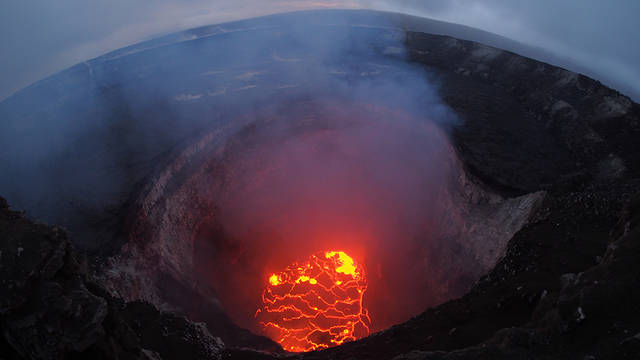Explosive eruptions at Kilauea’s summit possible, geologists warn



COURTESY U.S. GEOLOGICAL SURVEY
As seen from the Jaggar Museum overlook at Hawaii Volcanoes National Park, an ash column rises from the Halemaumau crater at the summit of Kilauea volcano shortly before 8:30 a.m. today. The explosion, which was short-lived, was triggered by a rockfall from the walls of Overlook crater, geologists say. This explosion was not caused by the interaction of the lava lake with the water table, they said.

COURTESY U.S. GEOLOGICAL SURVEY
Kilauea volcano’s summit lava lake at Halemaumau has dropped significantly over the past few days. This view captures the north portion of the Overlook crater.




Scientists at the Hawaiian Volcano Observatory are warning that the steady lowering of the Halemaumau lava lake at Kilauea volcano’s summit overlook crater indicates that explosive eruptions are possible in the coming weeks.
HVO said that there is typically “very little warning” of steam-driven explosions at volcanoes.
“If the lava column drops to the level of groundwater beneath Kilauea Caldera, influx of water into the conduit could cause steam-driven explosions,” the warning issued this morning said. “Debris expelled during such explosions could impact the area surrounding Halemaumau and the Kilauea summit. At this time, we cannot say with certainty that explosive activity will occur, how large the explosions could be, or how long such explosive activity could continue.”
The hazards of an explosive eruption are ballistic projectiles and ashfall, scientists said.
“During steam-driven explosions, ballistic blocks up to 2 yards across could be thrown in all directions to a distance of 0.6 miles or more. These blocks could weigh a few pounds to several tons. Smaller (pebble-size) rocks could be sent several miles from Halemaumau, mostly in a downwind direction,” they said.
“Should steam-driven explosions begin, ash clouds will rise to greater elevations above ground. Minor ashfall could occur over much wider areas, even up to several tens of miles from Halemaumau,” the warning continued. “In 1924, ash may have reached as high as 20,000 feet above sea level. Small amounts of fine ash from these explosions fell over a wide area as far north as North Hilo (Hakalau), in lower Puna, and as far south as Waiohinu.”
Don't miss out on what's happening!
Stay in touch with breaking news, as it happens, conveniently in your email inbox. It's FREE!
Gas emitted during steam-drive explosions will be mainly steam, but will include some sulfur dioxide.
Residents of the summit area should learn about the hazards of ashfall, stay informed of the status of the volcano and area closures, and review family and business emergency plans, HVO said. More information is available at https://volcanoes.usgs.gov/volcanic_ash/ Opens in a new tab
———
For more information: https://volcanoes.usgs.gov/volcanoes/kilauea/status.html Opens in a new tab.
Resources on volcanic ash can be found at: https://volcanoes.usgs.gov/volcanic_ash/ Opens in a new tab.



